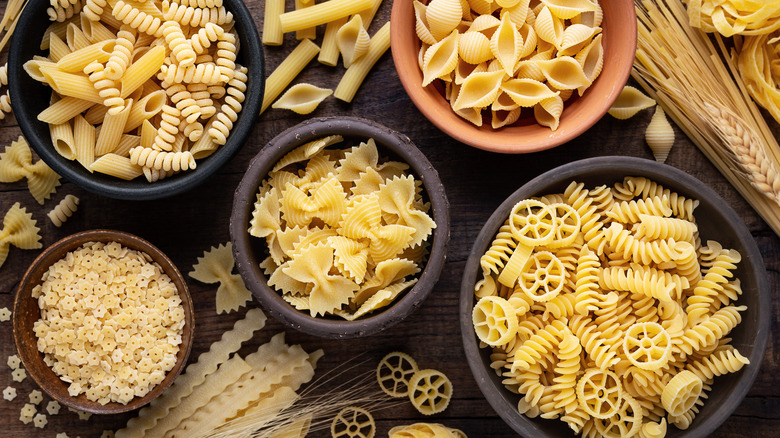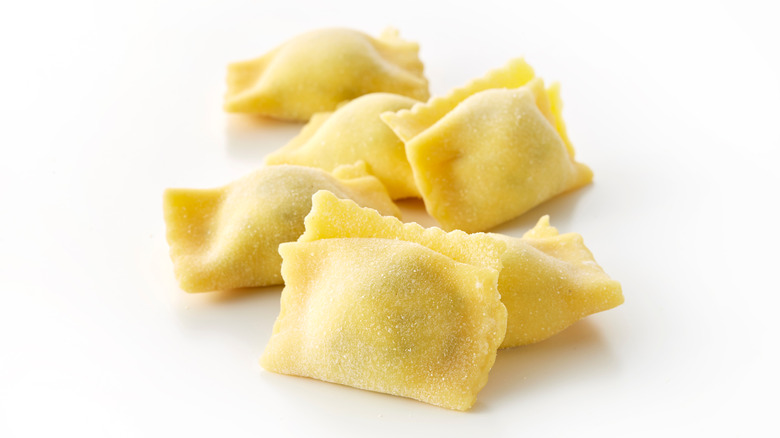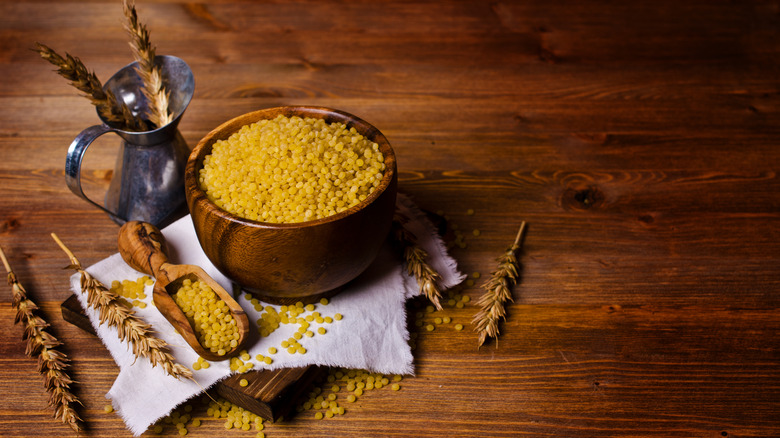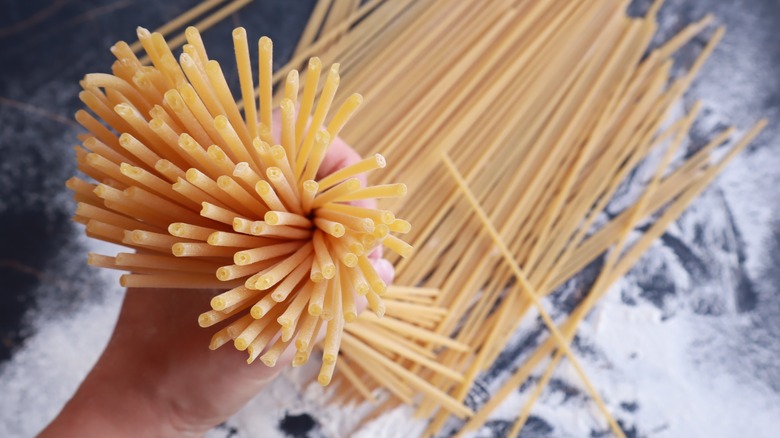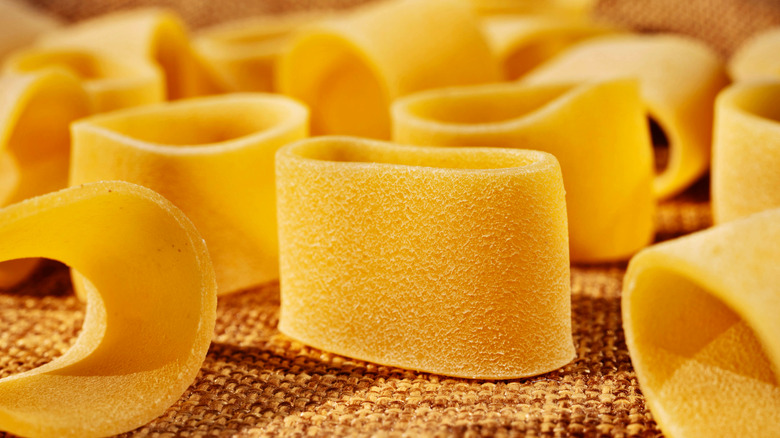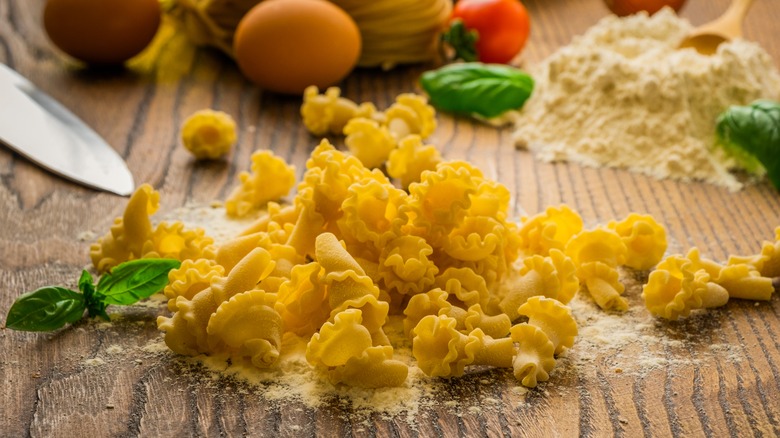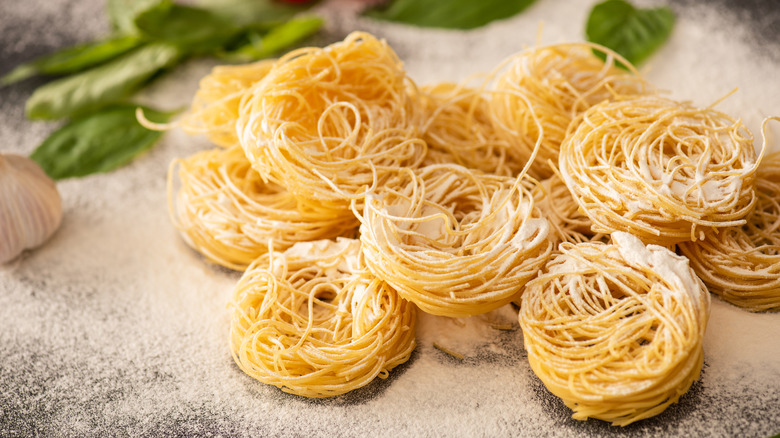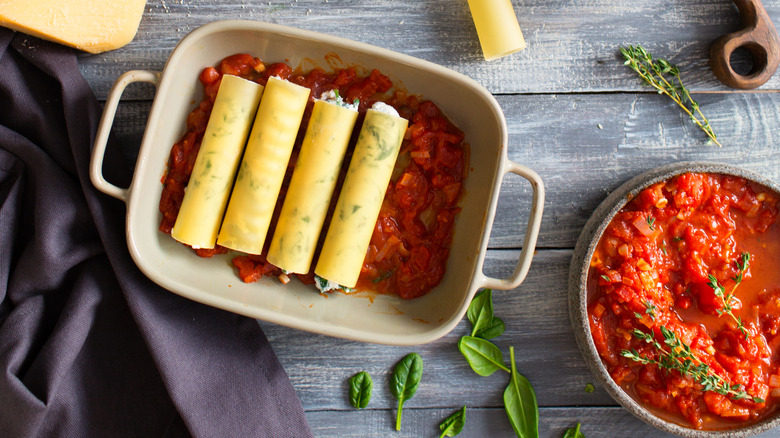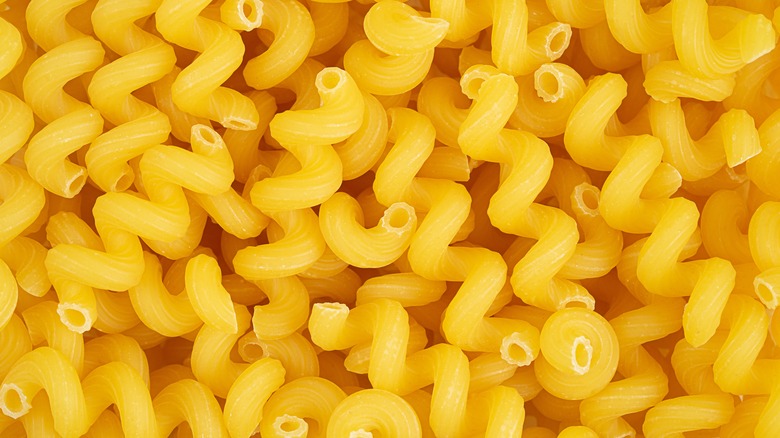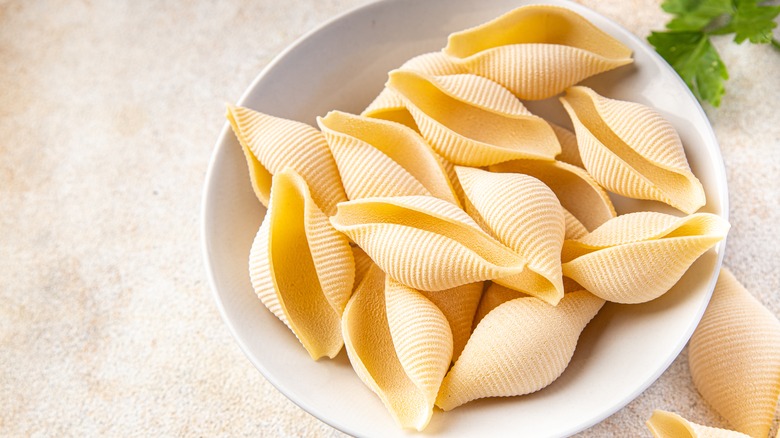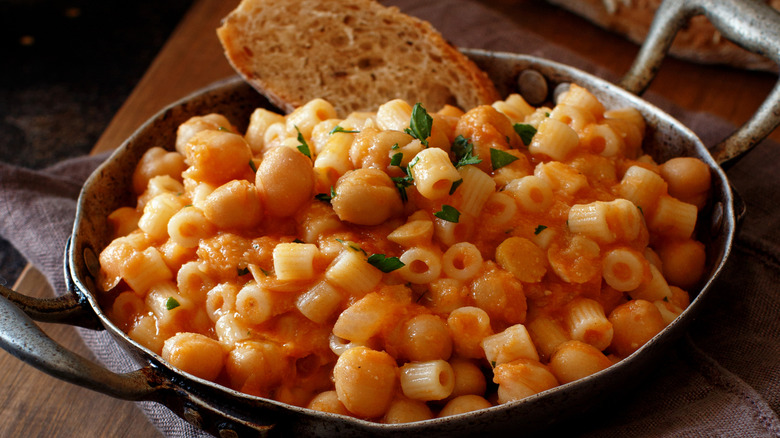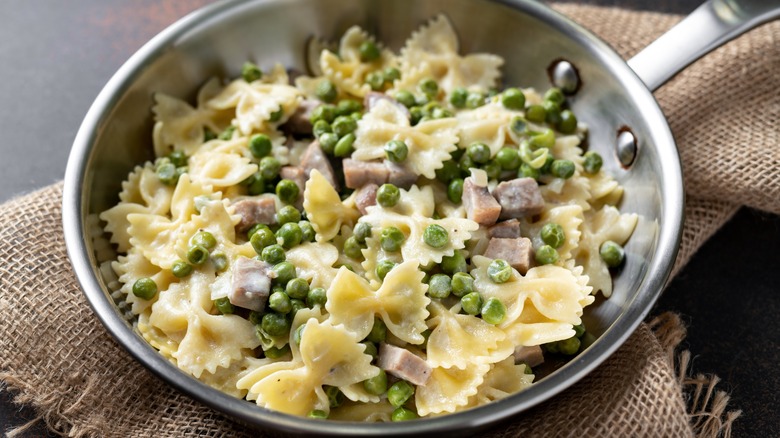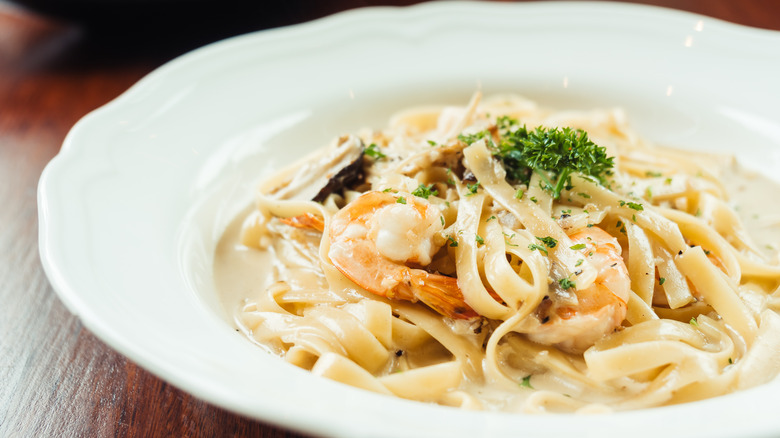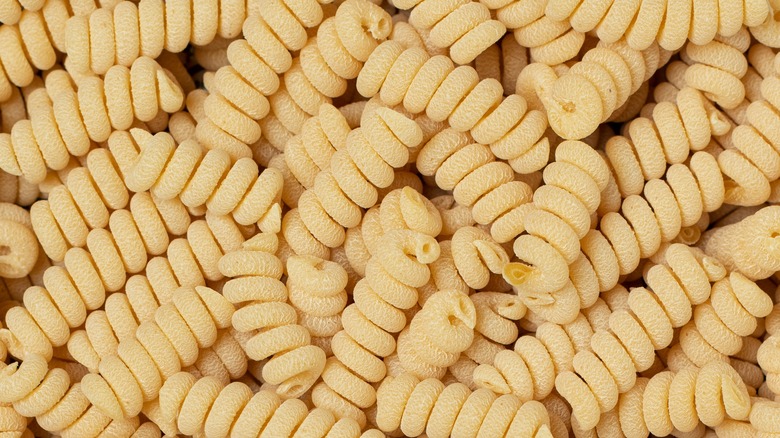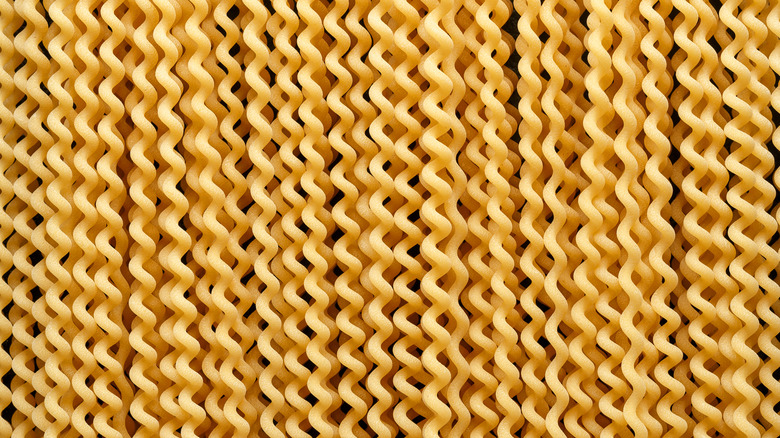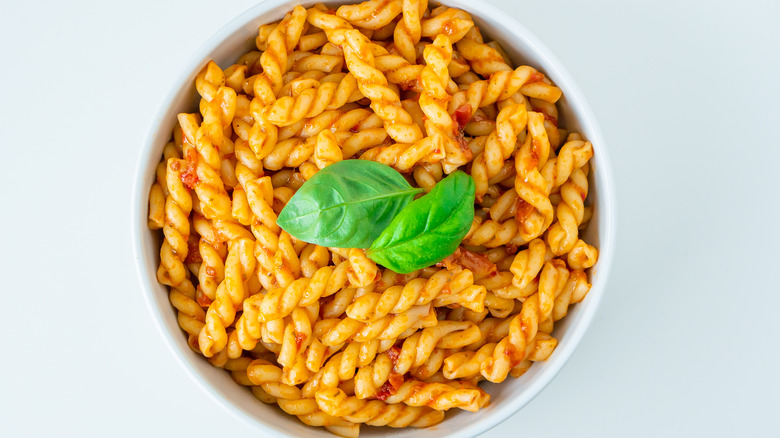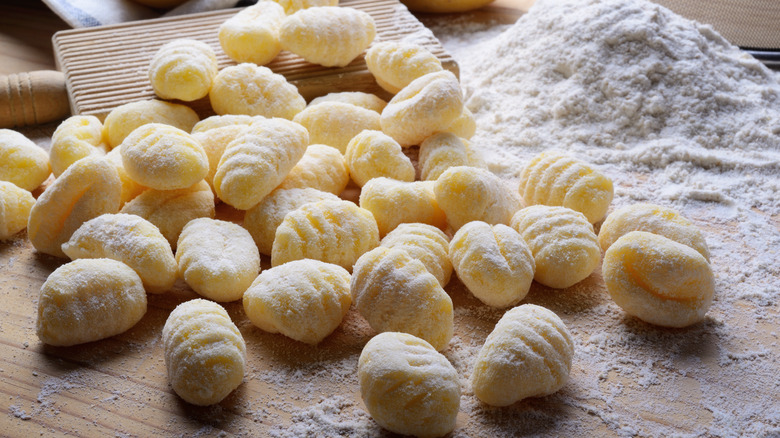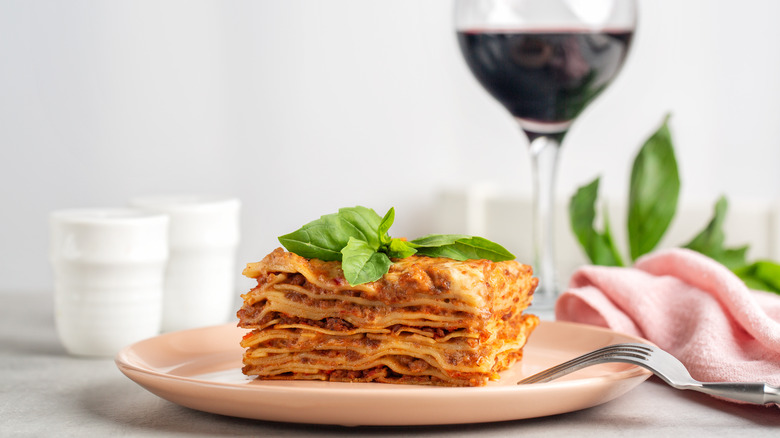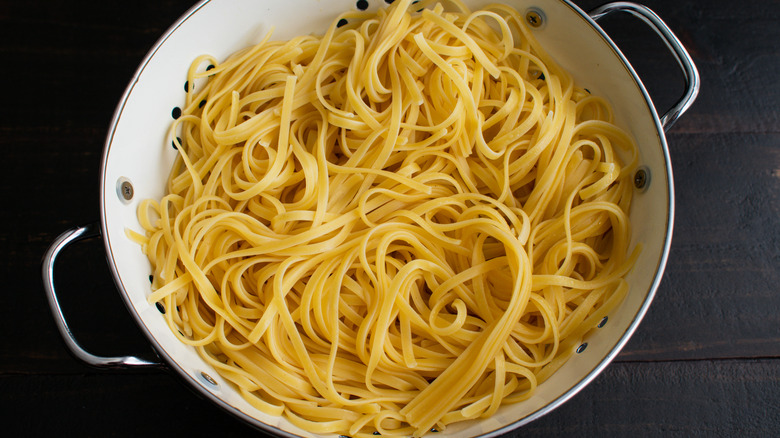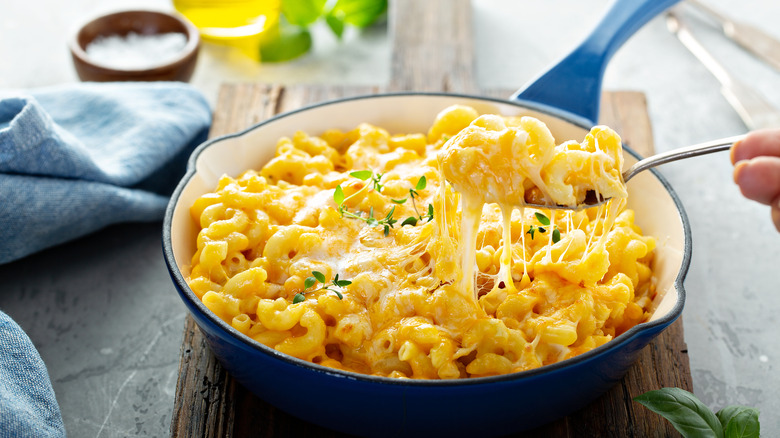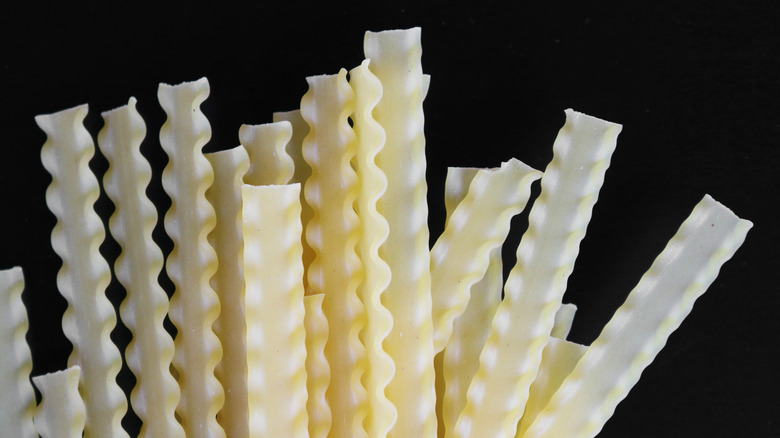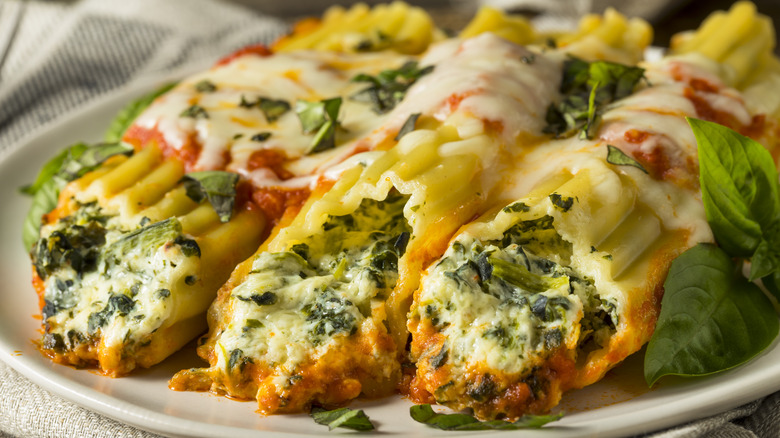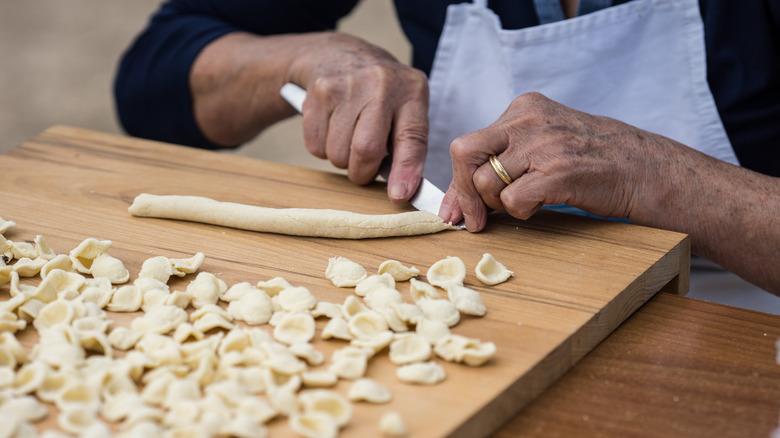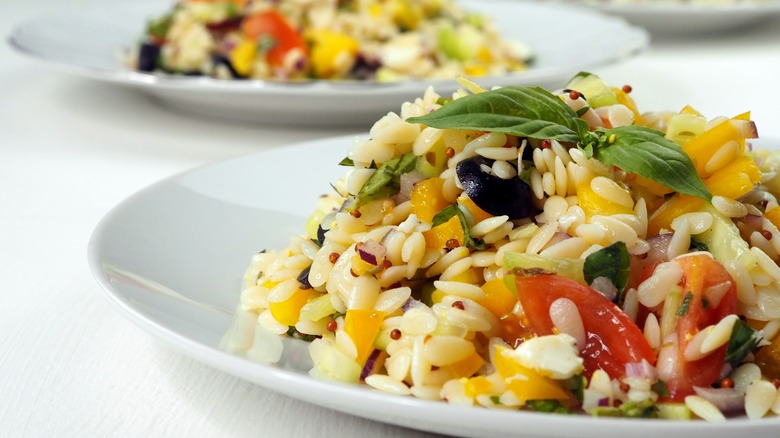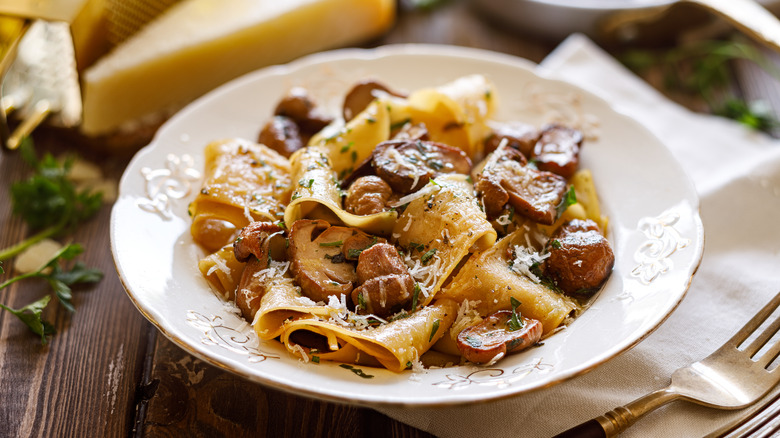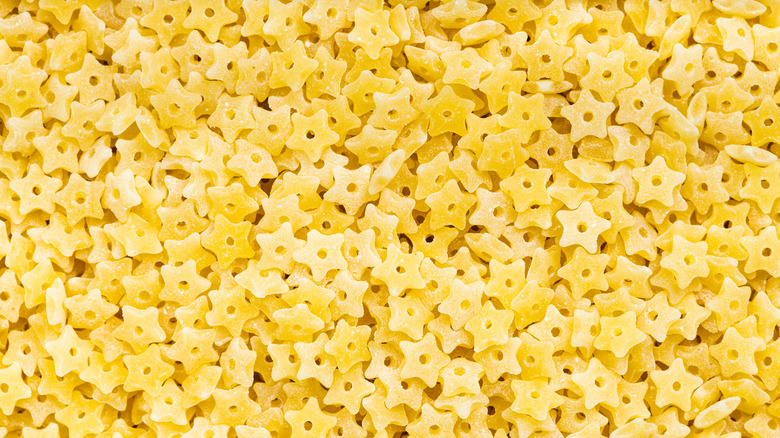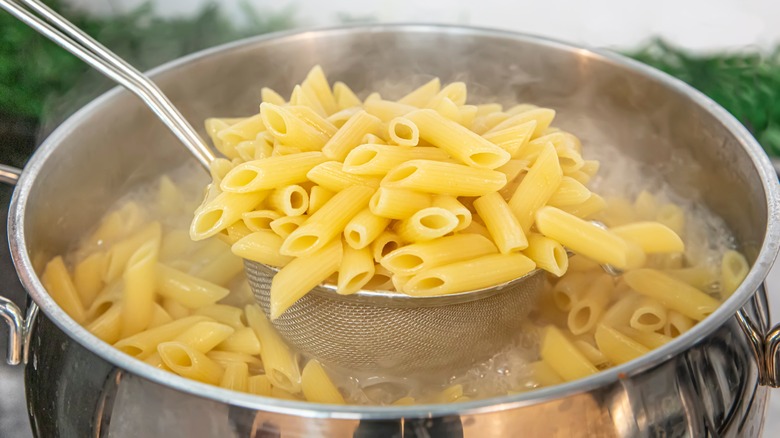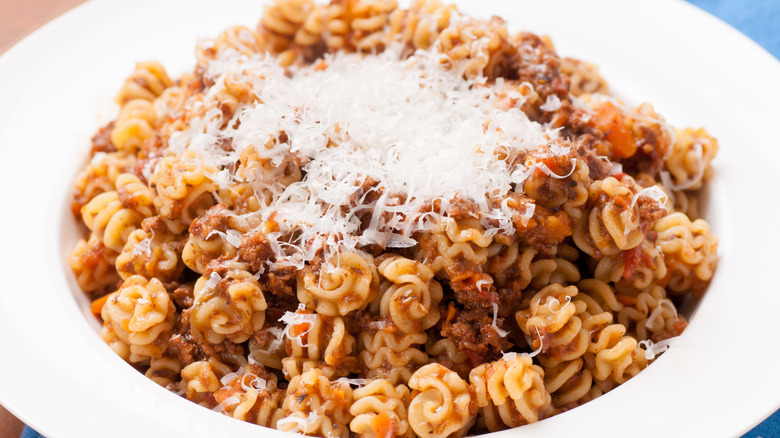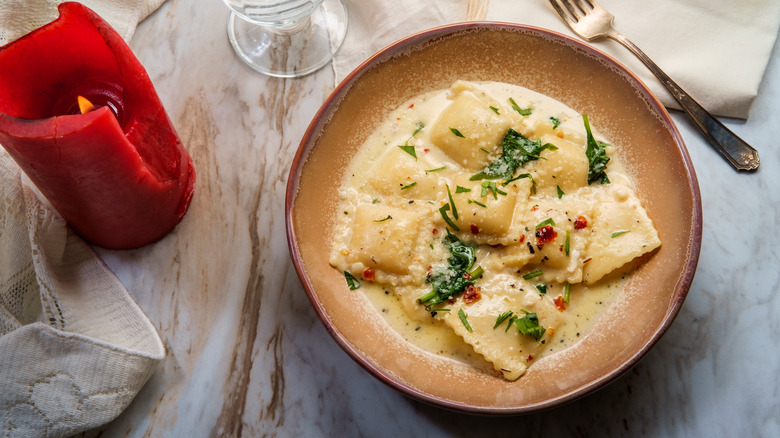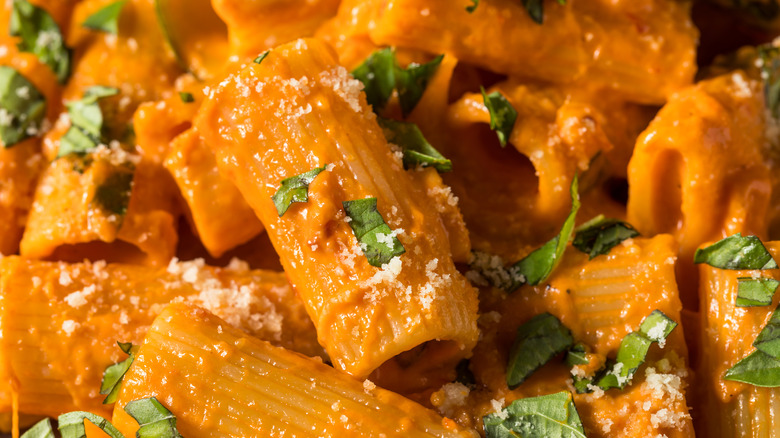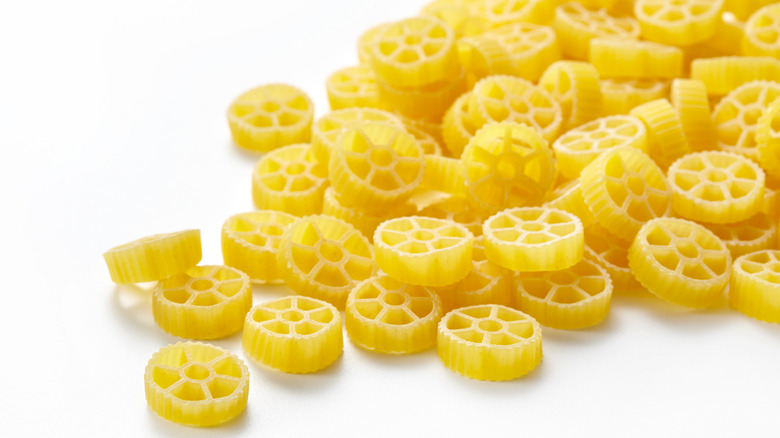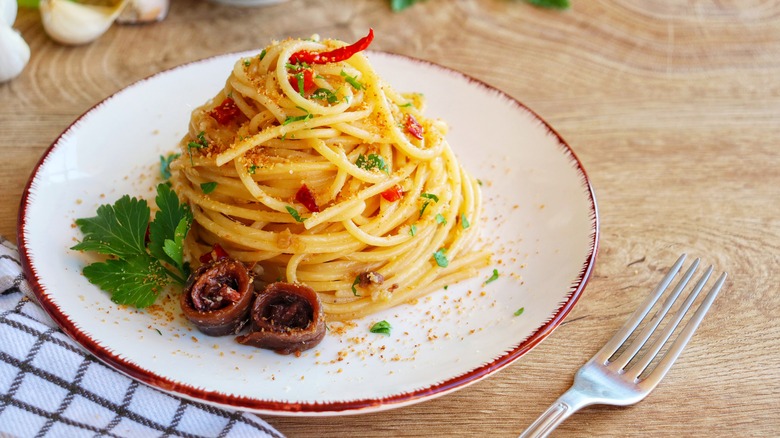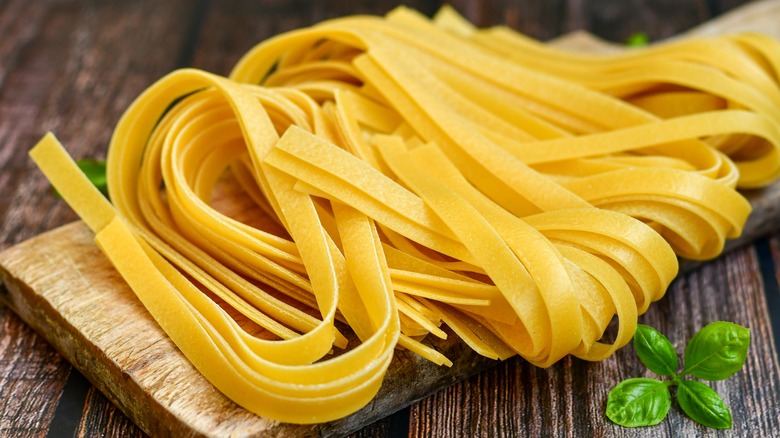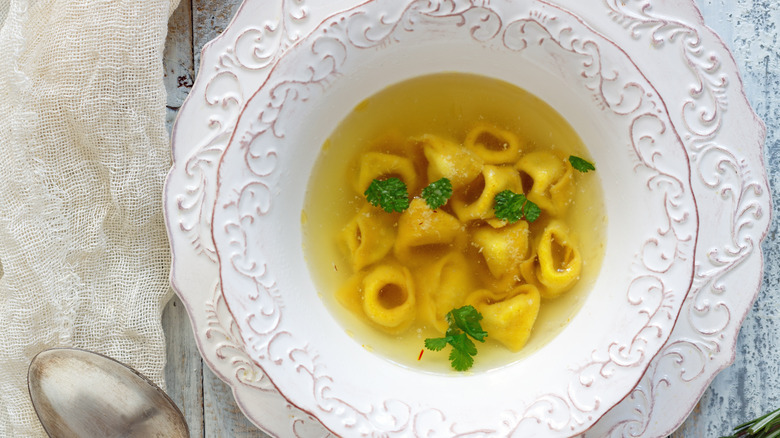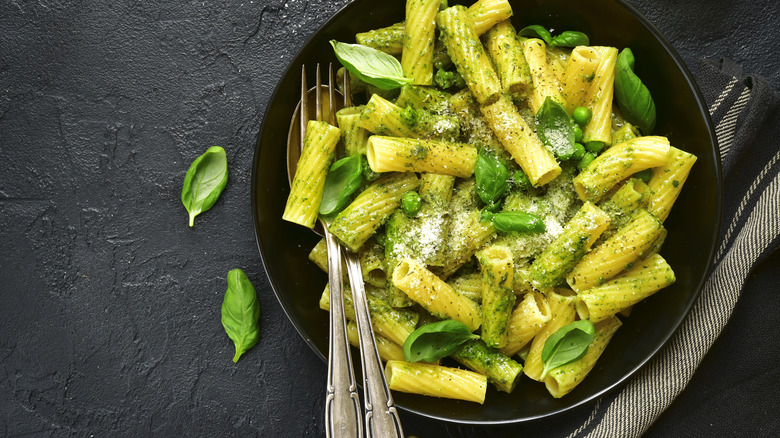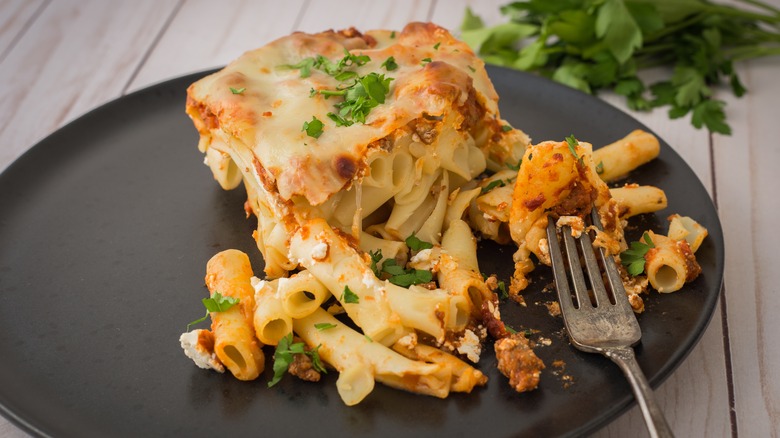The Ultimate Guide To Pasta Shapes
We may receive a commission on purchases made from links.
Italians are serious about their cuisine, and perhaps no food is more quintessentially Italian than pasta. It's simple at first glance: just flour and water and often egg, mixed into dough and formed into various shapes. But you can take one look at the pasta aisle at any market and easily become overwhelmed by the seemingly endless variety.
The whimsical array of pasta shapes is not just for show. Each type of pasta is best suited to a particular use due to its specific shape, size, and texture. Each nook and cranny, or lack thereof, is there for a reason — to best enhance the sauce, meat, or other ingredients that the pasta is meant to be paired with. Sturdier, thicker pastas can withstand longer cooking times, while delicate shapes should be treated gently.
There are a few major categories that most pasta shapes fall into: long thin strands, long flat noodles, tubes, stuffed pastas, tiny shapes known as pastina, and textured shapes made to capture sauce. From the simplest hand-made noodles to the most complex machine-extruded forms, here's a comprehensive guide to some of the more common pasta shapes you'll find in markets and on menus.
Agnolotti
Agnolotti (pronounced ah-nyuh-LOHT-tee) are part of the family of stuffed pastas, in which the rolled-out dough sheets are folded or layered over a filling, typically some combination of meat, cheese, and vegetables. Compared with their stuffed pasta brethren such as ravioli, agnolotti tend to be smaller in size. They are made using a single sheet of pasta that's folded over the filling and sealed. A unique version of this pasta, known as agnolotti al plin, are named as such because of the pinching technique that's used to create each parcel — plin is the word for "pinch" in the local dialect of Piedmont, where this pasta originated.
Acini di pepe
Similar in appearance to couscous, acini di pepe (pronounced ah-CHEE-nee) are one of the smallest varieties of pasta around. In fact, the name translates to "peppercorns," which they definitely do resemble in size and shape. This little golden nuggets are often used in soups, as their diminutive size makes them easy to scoop up with a spoonful of liquid. This shape is most famous for its role in Italian Wedding Soup, and is perhaps most infamous as the pasta component in Frog Eye Salad, a sweet, fruity American dish that's a popular Thanksgiving side in some western states.
Bucatini
Bucatini looks like a simple long, round noodle at first glance, similar to spaghetti. But look closely and you'll see what makes it special: it's hollow. The hole that runs through the length of a bucatini noodle technically makes it part of the tube pasta family, like penne and ziti. You get the best of both worlds with this wonder pasta — the fork-twirling fun of a long noodle, and the satisfying sauce-stuffed center of a tube.
Any silky, sleek sauce that can make its way inside bucatini's center is a good pairing with this shape. Bucatini all'Amatriciana shows off this pasta perfectly, with an umami-packed tomato-based sauce that coats and fills these noodles, maximizing each bite's flavor.
Calamarata
The thick, short rings of calamarata pasta are evocative of sliced calamari, and that's intentional — this pasta hails from the seafood-rich cuisines of southern coastal Italy, and is often paired with the squid that inspired its shape and name. You can also find a version of this pasta that's dyed black with squid or cuttlefish ink, making it an even more suitable partner for seafood-based sauces and ingredients.
This shape isn't made for sleek, elegant sauces, but it's perfect for more rustic recipes with big flavors. That's because the wide holes in each piece of calamarata act as pockets for substantial ingredients, like fresh tomatoes and chunks of fish such as tuna, giving each bite a toothsome texture. And the thickness of the pasta gives it enough body and flavor to stand up to bolder elements like chile and garlic.
Campanelle
Campanelle is a uniquely shaped pasta that looks like a cone with ruffled edges. This winsome noodle's name translates to "bellflowers" because of its resemblance to petals. Not only is this pasta visually stunning, it's also one of the best for flavor. This is because the cup-like shape traps sauce inside, making each bite an explosive burst of taste. Smooth, silky sauces are great with this shape, along with ingredients that are small enough to fit inside the hollow centers of each piece. It's also great with textured sauces, like in a chunky pesto recipe, or one packed with toothsome ingredients.
Capellini
Capellini is basically skinny spaghetti. The thinnest version of this shape is called capelli d'angelo, which translates to angel's hair. These impossibly slender strands of pasta are incredibly delicate and should be prepared with caution, as they only need the briefest cooking time to reach their perfect al dente stage. Light and fresh is the way to go when pairing flavors with these dainty noodles, as they can become easily overwhelmed with too much intense flavor or texture. A bright pesto sauce or a simple toss with olive oil and garlic would be perfectly suited to this shape. Try Randy's Lemon Capellini in the summer when fresh tomatoes and basil are in peak season.
Cannelloni
Making cannelloni couldn't be simpler: you take a basic egg pasta dough, roll it out thin, and form it into long tubes. These cylinders can then be filled with anything you can imagine, from cheese to ground meat to veggies or any combination of these ingredients. They're well-suited to baked dishes, as they're basically the same as lasagna, just in a different shape. Cannelloni are a perfect blank pasta canvas, ready to take on any flavors. You can keep things traditional with Cannelloni di Carne, or go all-out gourmet with wildly creative combinations like this Lobster Cannelloni With Grilled Eggplant Carpaccio.
Cavatappi
Cavatappi translates to "corkscrews," and one look at these noodles shows that the name couldn't be more apt. The spiral shape and hollow center of this pasta makes it perfect for trapping sauce on the inside and chunkier ingredients on the outside. And because it's a fairly sturdy pasta, it can stand up to strong flavors and keeps its shape well even in the oven. This makes it a fantastic option for Baked Mac and Cheese. It's also a good choice for pasta salads, as its solid texture will hold strong even when tossed in dressing, so it won't get mushy like a more delicate pasta might.
Conchiglie
Conchiglie (pronounced con-KEEL-yeh) is the Italian name for shells. This pasta shape comes in multiple sizes: the smallest ones are known as conchigliette, the next size up are conchiglie, and the big ones are called conchiglioni. The large hollow pockets of conchiglie serve as empty vessels for other ingredients, which vary based on what size you're using. The little ones are great with rich, smooth sauces and cheese, medium sized shells can handle chunkier accompaniments like meat sauces, and the large or jumbo conchiglioni can be stuffed and baked similarly to cannelloni and other large tubular pastas. These shells are fairly sturdy, no matter what size, making them highly versatile.
Ditalini
Ditalini, which translates to "little thimbles," are small, short tubes of pasta. These cute little carbs are perfect in soups that call for pasta, adding body and bite to broth. They're also good mixed with simple sauces or simply tossed with a bit of butter and cheese for a comforting snack. Thanks to their size, they cook rapidly, so they're a great shape to have on hand for when you need a quick pasta fix. The recipe that this shape is best known for is Pasta e Fagioli, a hearty stewed dish featuring these tiny tubes and white beans within a broth made of stock and plum tomatoes.
Farfalle
Farfalle literally translates to "butterflies," but this shape is more commonly referred to as bowtie pasta — to be fair, it resembles both pretty well. Pinched in the middle and flared at the ends with ruffled edges, farfalle noodles are versatile and can be utilized successfully in many different pasta preparations. Their texture lies somewhere between sturdy and delicate, meaning you can pair them with subtle or strong ingredients. Their unique shape has a decent amount of surface area for sauce to adhere to, whether it's a rich and creamy Alfredo or a bright marinara. It's an excellent shape for pasta salads, too, if you want something a little bit more delicate than fusili or cavatappi but larger than orzo or pastina.
Fettuccine
Fettucine is part of the category of long, flat noodles. The name literally translates to "little ribbons," and that's just what they are — sleek and elegant, these noodles are about half the width of tagliatelle. Fettucine has enough heft to stand with rich, creamy sauces and other intensely flavorful ingredients, along with a delicacy that brings sophistication to every dish. To really let fettucine shine like the star it is, try this Pasta with Classic Alfredo Sauce, which uses pasta water, butter, and grated cheese to create a silky, noodle-coating sauce that's lighter than your typical cream-based version. Fettucine noodles love light yet luxurious additions like mushrooms, lobster, and shrimp, too.
Fusilli
Roughly translated to mean "spindle," fusilli is a short-cut noodle that's twisted into a tight spiral shape that resembles a spring. The grooves of each piece of pasta are perfect for capturing sauce, and fusilli's density gives it a satisfyingly toothsome texture. It's often confused with rotini, which is also spiral shaped, but fusilli is formed by twirling a noodle around a rod and has a hollow center, while rotini does not.
Fusilli has a strong enough structure to keep its form during long cooking processes, making it suitable for bakes. It's also an excellent choice for pasta salads, as it won't go mushy when coated in dressing. Its flavor-trapping ridges work well with textured sauces, like pesto or Bolognese, as the little chunks of ingredients get locked into the hollows of each noodle, leading to extra tasty bites.
Fusilli col Buco
Col buco translates to "with the hole," an appropriate for this pasta name considering that it's made from noodles that have a hollow center. Fusilli col buco is basically bucatini wrapped around a rod to give it a spiral shape, leading to extra flavor-trapping curls in each strand. These twirly noodles are a fantastic pairing with textured sauces and chunky ingredients, as their curves are great at locking in any bite-sized morsels. The hollow centers soak up any silky oils or sauces, too, giving you a double dose of flavor and plenty of versatility when it comes to toppings and accompaniments.
Gemelli
At a glance, gemelli (pronounced jay-MEH-lee) resemble other short twisted pasta shapes such as fusilli and rotini. But their structure is slightly different. While fusilli is made from a noodle twisted around a rod, and rotini is extruded into a spiral shape, gemelli is a single noodle twisted around itself. The name translates to "twins," referring to its dual-spiral appearance, somewhat like a DNA double helix shape.
Just like other similar twisted short noodles, gemelli have plenty of ridges and crannies to capture sauce. The noodles are more tightly wound than others, though, with fewer gaps in between the twirls. Thus, this shape is better with sleeker, creamier sauces than it is with chunkier ingredients. Pesto is a great choice, or try this Gemelli with Butternut Squash recipe, which coats the noodles with a silky squash puree.
Gnocchi
Before potatoes made their way to Europe in the 16th century, little dumplings known as gnocchi (pronounced NYOW-kee) were made from ingredients like flour, breadcrumbs, ground nuts, and cheese. Potato gnocchi are relative newcomers, first appearing in the 19th century, but now dominate the worldwide gnocchi scene. Riced potato is mixed with egg, flour, and salt, rolled into a rope, and then cut into small pillow shapes. They can be left smooth or ridged to capture more sauce.
When made properly, they're both light and hearty, with a fluffy yet substantial texture. Like potatoes themselves, gnocchi are very versatile. They are as at home when simply tossed in butter and herbs as they are swimming in a rich, meaty ragú.
Lasagna
Lasagna refers to a category of dishes as well as the pasta shape that's used to make them. Lasagna noodles are flat, long, and wide, sometimes with ruffled edges, and are made to be layered with sauces and other ingredients and baked. Some lasagna noodles need to be boiled first, while others are made to cook fully in the oven.
Classic lasagna makes good use of these noodles while a traditional Lasagna alla Bolognese is the traditional recipe using these noodles. Originating in the region of Emilia Romagna, and consisting of creamy bechamel and savory meat sauce layered along with cheese, it's a delicious pasta dish. There are countless regional variations of the dish throughout Italy, including Naples' tomato and meatball version and Liguria's light pesto-based recipe.
Linguine
Linguine is part of the long noodle family. It lies somewhere between spaghetti and fettucine, but is flatter than the former and thinner than the latter. In Italian, linguine means "little tongues." Its rather delicate shape and texture match up well with light sauces and bright flavors. Seafood goes particularly well with this type of noodle, along with fresh herbs and zesty citrus. Linguine with Clams is a classic combo that makes use of this type of pasta. If you're making a richer, meatier sauce, you might want to opt for a heftier noodle like fettucine or tagliatelle, but linguine is the way to go with ingredients like shellfish, poultry, and white wine or oil-based sauces.
Macaroni
In the United States, macaroni refers to elbow pasta, a short-cut hollow pasta shape with a subtle curved bend. It's basically cavatappi that's been cut into smaller pieces. In Italy, however, the pasta term maccheroni refers to many different pasta shapes, most of them hollow tubes, that each have their own specific names — some examples are pipe and gomito (which literally translates to "elbow").
Elbow macaroni is, of course, most famous for the classic comfort food macaroni and cheese. Its relatively thick walls allow it to stand up to rich, dense sauces, so you can load these noodles up with as much cheese as you want, whether you're going with a classic style Mac and Cheese or a creative variation like Buffalo Chicken Macaroni and Cheese.
Mafaldine
Mafaldine is a pasta shape with a truly unique story attached. While a version of these long, wide noodles with ridged edges likely existed before, in 1902 it was introduced to the world as a new shape called mafaldine, in honor of the newly-born Princess Mafalda of Savoy. It's also known as reginette, or "little queens," in honor of its namesake. While the Princess met a tragic end perishing in World War II, her story lives on and this pasta serves as a reminder of her history.
The ridges along the sides of mafaldine noodles are great at capturing sauce, especially when they're twirled around a fork, creating textured pockets full of flavor. It's a versatile shape that goes well with simple or complex flavors, and light or hearty ingredients.
Manicotti
Manicotti and cannelloni are terms that are often used interchangeably to refer to larger tube-shaped pastas that are stuffed and baked. Manicotti is the more common name in the United States, and the tubes are usually ridged, as opposed to cannelloni which is smooth. The ridges are useful for adding flavor to each bite, helping the sauce, cheese, and other topping ingredients to stick to the outside of the pasta. Bolognese sauce or other meaty concoctions are often used to fill these tubes, as well as ricotta cheese sometimes mixed with vegetables like spinach. Sturdy manicotti can take on a lot of richness and bold flavors.
Orecchiette
Orechiette (pronounced oh-reh-KYET-teh) is a simple, rustic pasta shape. Unlike the majority of pastas in this guide, these are traditionally made without egg: only flour, water, and salt are needed. Meaning "little ears," these pasta pieces are made by taking a small piece of dough and flattening it with the tip of your thumb, creating a shallow cup shape. Originating from the region of Puglia, the heel of the boot, this pasta pairs well with southern Italian ingredients, and is often served with broccoli rabe. Other accompaniments that work beautifully are anchovies, garlic, and tomatoes. Sauce clings well to the edges and hollows of orechiette, making it ripe for sauce forward pasta dishes.
Orzo
The word orzo translates to "barley," as this pasta shape resembles that grain in both size and shape. It's also similar in appearance to rice, and can be used in some recipes as a rice substitute. Orzo is part of the pastina family of small pastas, along with other miniature shapes like acini di pepe. Like all pastina pastas, orzo cooks quickly thanks to its diminutive size, so it's important to keep an eye on it. Otherwise it can lose its texture. Orzo is well-suited for soups and salads, and is especially good with fresh Mediterranean flavors, like in this Greek-Style Orzo Salad.
Pappardelle
Of all the flat, long noodles, pappardelle is the widest, unless you count lasagna. The broad surface area of these noodles means they can hold their own with big, bold flavors, hefty ingredients, and rich sauces. Hailing from Tuscany, pappardelle is traditionally served with a meaty ragú made with local wild boar. If you can't get your hands on Tuscan boar meat, however, other meats such as veal, beef, and pork are good substitutes, like in this recipe.
Pappardelle's wide, simple shape makes it an easy noodle to make from scratch. If you're just starting to dip your toe in crafting homemade pasta, this is a great shape to consider.
Pastina
Pastina is a large category that includes many different pasta shapes — the one characteristic that they share is size. These are the tiniest shapes of pasta, and there are several dozen specific styles that have their own names. They're most commonly used in soups, as well as salads and other more traditional pasta dishes. What stands out is the fact that their cute size makes them a good choice for children's meals. They also cook quickly, helpful when you're looking for a last-minute snack.
Stelline are a popular shape of pastina, resembling little stars. Orzo and acini di pepe are other common styles. These little noodles work well to add texture and substance to light, brothy soups.
Penne
A form of short-cut tube pasta, penne is a popular shape thanks to its versatility. The name translates to "quills," as the ends are cut at an angle leaving a point that somewhat resembles the tip of a pen. Penne has firm, thick walls around their hollow center and are often ridged on the outside. All of these characteristics make it a successful pasta to pair with hearty sauces and intense ingredients, like this Spicy Roman Penne All'Arrabbiata, which pairs these noodles with a tomato sauce bursting with chile and garlic flavor. Penne's firm structure also helps it hold up well in pasta salads.
Radiatore
One of the oddest pasta shapes out there, radiatore are shaped after — as their name suggests — radiators. These unusual noodles have lots of deep grooves along their short-cut bodies, making them fantastic vessels for hearty sauces and ingredients, as there's plenty of room to pack in flavor. As a 20th century invention, radiatore are fairly modern when it comes to pasta styles. Their delightful shape brings visual fun to any dish, and their density and texture add to their appeal. Radiatore can be used in much the same way as other short, sauce-catching pasta shapes, like fusilli and gemelli.
Ravioli
Ravioli are pasta shapes that consist of sheets of dough that are layered and sealed around a filling. They come in a wide variety of shapes and sizes, from a single jumbo raviolo that's the size of a plate, to little pasta pockets as small as the tip of your thumb. Ravioli can be filled with anything you can come up with in your culinary imagination, usually involving cheese and some combination of herbs, meat, and vegetables. The filling is the main event when it comes to this pasta shape, so typically a simple oil or butter sauce is all that's needed to enhance the flavors packed within the pasta.
Rigatoni
A hollow tube-shaped pasta, rigatoni are short-cut noodles with ridges on their exterior surfaces — in fact, the word for ridged in Italian is "rigate," which is where this pasta gets its name. Their centers are wide enough to capture not just sauce, but chunky ingredients as well, like chopped, ground, or shredded meats or vegetables. These qualities make rigatoni noodles particularly well-suited to hearty, rustic sauces including Bolognese and other ragús. Intensely flavored ingredients shine with this pasta, like spicy sausage, roasted tomatoes, or salty, umami-packed elements, like anchovies and aged hard cheeses. Like many of the sturdy tube-shaped pastas, rigatoni bakes well in the oven, too.
Rotelle
Pasta that resemble little spoked wheels are called rotelle, which literally translate into "wheels." In English, this shape is sometimes referred to as wagon wheels or cartwheels. You may see a similar shape called ruote, which is just a smaller version of rotelle. The multiple nooks and crannies in each piece of rotelle pasta are great for capturing sauce and other ingredients so you get big flavor and texture in each bite. Meaty and creamy sauces match up well with this fun shape. It also bakes well, and holds up nicely in salads, making this not only a fun type of pasta, but also a versatile one.
Spaghetti
Ah, spaghetti — the classic noodle is probably what comes to mind when you hear the word pasta. The most popular variety of pasta in the world, spaghetti is versatile and always reliable, featuring long round strands that can be easily twirled to pick up sauce and bits of ingredients. The end result provides you with a firm forkful of flavor in every bite. Spaghetti's middle-of-the-road size and toothsome yet somewhat delicate texture means it works with lots of recipes. The four classic Roman pasta dishes – alla gricia, all'amatriciana, cacio e pepe, and carbonara — are typically made with spaghetti.
Tagliatelle
The word tagliare means "to cut," and that's how you make tagliatelle (pronounced tah-lee-ya-TELL-eh) noodles. To craft this decadent carb, a rolled out sheet of fresh pasta is sliced into long ribbons. Tagliatelle is wider than fettucine, but narrower than pappardelle — specifically, it must be between about seven millimeters wide when it's cut, and expand to eight millimeters wide after it's cooked to be considered authentic. It's a good match with hearty sauces, like meaty Bolognese, as well as rich and flavorful ingredients such as porcini mushrooms or fresh truffles. These noodles can be made by hand relatively easily (make sure to have a ruler ready), and they're exceptionally silky and luxurious when enjoyed fresh.
Tortellini
From the Italian word torta, meaning cake or pie, we get several pasta names: tortelli, tortelloni, and tortellini. All of these are in the stuffed pasta family. Tortelli are large pasta pockets similar to ravioli and come in many different shapes, while tortelloni and tortellini are both ring-shaped. This unique form is made by folding a round sheet of pasta around filling and sealing it, then bringing the ends together. The resulting shape has lots of folds and nooks perfect for trapping sauce and other flavorful bits.
Tortellini are smaller than tortelloni, and are typically stuffed with meat, while the other larger size are often filled with cheese and vegetables. The classic Emilia Romagna dish Tortellini en Brodo features these meat-filled pasta rings in a comforting savory broth.
Tortiglioni
Tortiglioni (pronounced tohr-tee-LYO-nee) are part of the tube pasta family. They're very similar to rigatoni, with a twist — literally. The ridges along the exterior of the tubes twist around the noodles at an angle, giving this pasta shape visual appeal as well as sauce-capturing properties. Just like rigatoni, tortiglioni are well-suited for rich, hearty sauces, especially ones that include hunks of meat and vegetables that can get trapped inside the center of the pasta. A textured sauce like pesto works as well, with its bits of flavor adhering nicely to the noodles' angled ridges. Oozey, cheesy bakes are a good use for this sturdy pasta, too.
Ziti
Ziti are short, hollow tube-shaped noodles. They're somewhat similar to penne, but without ridges, and their ends are cut straight rather than at an angle. Traditionally in Campania, where this shape hails from, ziti come in longer noodle forms and are broken by hand into smaller pieces before cooking. This pasta is often served on holidays and special occasions, especially weddings, in the region. It can be served with a simple tomato sauce, or a heartier accompaniment like ragú alla Napoletana, a long-simmering, powerfully flavor-packed meat sauce made with beef and pork. Ziti is often baked, which gives the pasta a soft, buttery texture.
